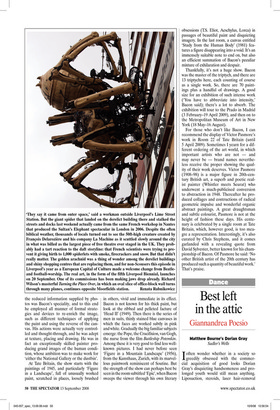Best left in the attic
Giannandrea Poesio
Matthew Bourne’s Dorian Gray Sadler’s Wells
Ioften wonder whether in a society so greedily obsessed with the commercial acquisition of good looks Dorian Gray’s disquieting handsomeness and prolonged youth would still mean anything. Liposuction, steroids, laser hair-removal and impossible fitness programmes have eroded and detracted from what once was the notion of ideal beauty, transforming the exceptional into the unexceptional. This is, in my view, the core problem of Matthew Bourne’s latest and much-hyped creation, Dorian Gray. By turning Oscar Wilde’s negative hero into a hunky supermodel, the ever so inventive dance maker inferred a lethal blow to the character’s intoxicating charisma; his Dorian, with cropped hair and chiselled body is merely one of the many hunks who invade our daily lives from the pages of every magazine. As such he has none of the ‘impossible’ beauty or outstanding diabolical seductiveness of his literary counterpart. Don’t get me wrong, though, such a shallow portrayal has nothing to do with Richard Winsor’s sound interpretation of the main role, but stems exclusively from the uneven dramaturgic and choreographic layout of the work itself.
Only now and then, hidden amid long stretches of tiresome and uninventive choreography, are glimpses of a vibrant modern-day theatrical reading of Wilde’s novel. Take, for instance, Dorian’s morbid fascination with the camera, which he flirts with and lusts for in the highly charged homoerotic duet between him and Bourne’s choreographic equivalent of Wilde’s Basil Hallward — portrayed here as an irresistibly debauched, long-haired fashion photographer (Aaron Sillis). The intense interaction with the camera, which doubles in the duet as a kinky toy and as a not-so-subtle metaphorical device — the final flash is more than obviously a climax — hints at the protagonist’s splendidly dark and twisted psychology. Or take Dorian’s dopplegänger (Jared Hageman), who, not unlike the famed portrait, haunts the protagonist by mirroring him and gradually taking over his own microcosm.
Unfortunately, what could have been two great dramatic threads get totally lost under an overwhelming amount of superficial padding. The narrative, therefore, never goes beyond the click-and-tell dimension of a gossip magazine, packing in stereotype after stereotype. The theoretically pivotal character of Lady H (Michela Meazza), Bourne’s female equivalent of Wilde’s Lord Henry, is too Sex and the City meets The Devil Wears Prada to gain any dramatic depth; similarly, the male ballet dancer Dorian falls in love with, another of Bourne’s gender-twisting interventions on the original story, is too much of a camp caricature of the proverbial ballet ‘queen’; thus his tragedy, the first to hit Dorian’s gilded life, has little or no dramatic impact. He dies like Juliet in MacMillan’s Romeo and Juliet — references to which are made both musically and choreographically — after a scene that draws upon the graphic sensationalism favoured by most soap operas when dealing with drug issues.
In Bourne’s usual style, all sorts of injokes fill what is a messy canvas badly in need of some drastic editing. Unfortunately, the more highbrow ones, such as Dorian’s visit to the Royal Opera or his radio alarm clock blurting excerpts from Tchaikovsky’s Sleeping Beauty, come across as a repeat of far more hilariously effective ones seen in previous and more engaging works of his. As for the more lowbrow ones, including a spoof of Tonight with Jonathan Ross, they are so lame that they failed to elicit laughter at a Saturday matinee. By the time the second act begins all the clever ideas have run out of steam. The action becomes choreographically repetitive and dramaturgically garbled. Despite the haunting presence of the dopplegänger, Dorian’s descent into hell is hell to watch and digest. No trick is spared. Blood, rape, zombies, the smothering of the haunting double and a herd of paparazzi feasting on Dorian’s lifeless body turn the last 20 minutes into a whirlpool of wham-bam solutions the scriptwriters of Dallas would have paid good money for.
There is no doubt the click-and-tell approach will make a hit of this work, especially among the various A-level dance and performing arts students who, thanks to the cultural blinkeredness imparted by the flawed syllabi they study, will find it daringly innovative. Not to mention the success it will likely have among the shock-thirsty inhabitants of puritan-land across the pond. Pity, for somewhere inside all that lurks a potential theatre gem — I only wish it had not been locked up in the attic.











































































 Previous page
Previous page